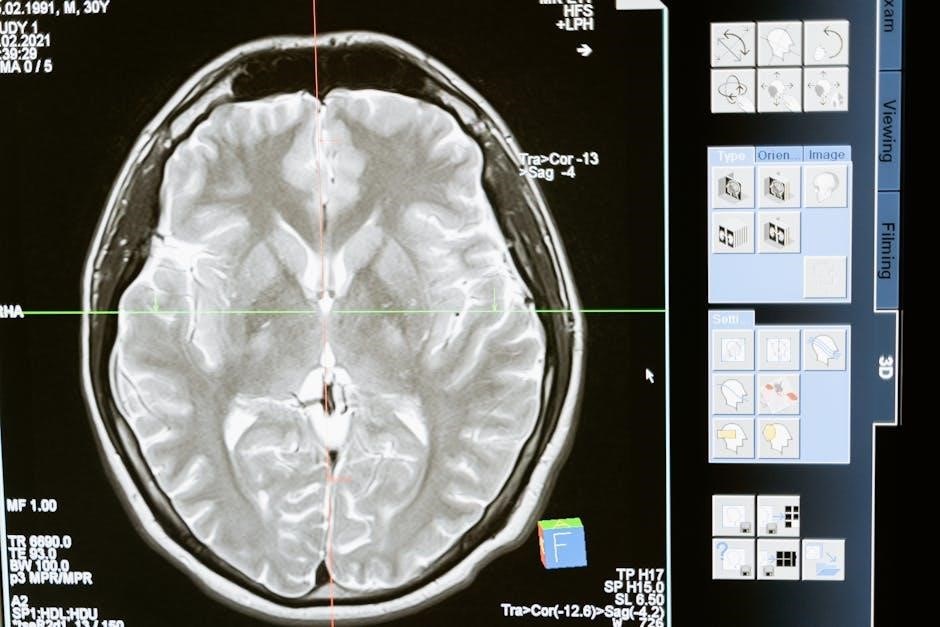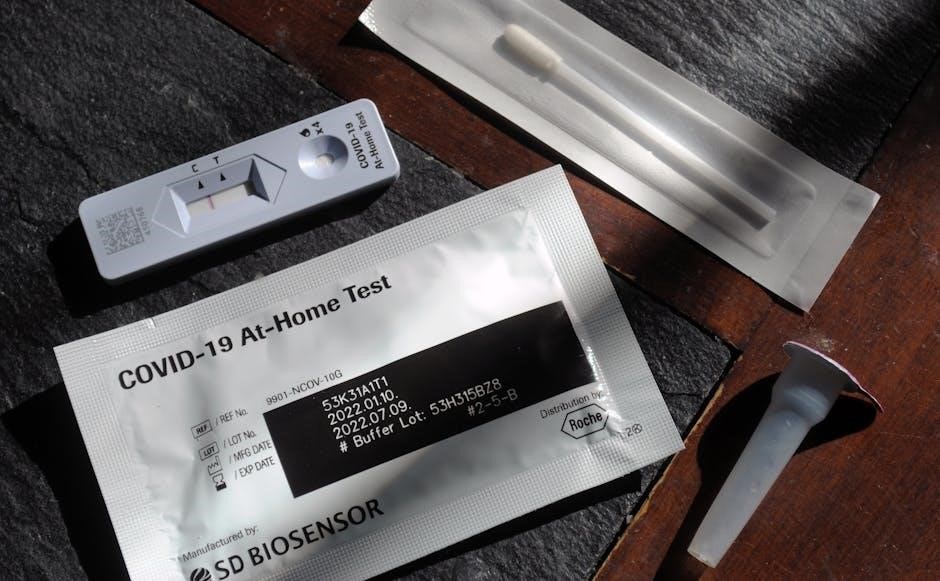QuickVue Rapid Strep Test Instructions: A Comprehensive Guide
This guide provides detailed instructions for using the QuickVue Rapid Strep A Test. It is intended for the rapid detection of Group A Streptococcal antigen directly from patient throat swab specimens. The test utilizes immunoassay technology for qualitative detection.

Intended Use of the QuickVue Strep A Test
The QuickVue Strep A Test is designed for in vitro diagnostic use, specifically for the rapid, qualitative detection of Group A Streptococcal antigen. This antigen is directly identified from throat swab specimens obtained from patients suspected of having strep throat. The test is intended to assist healthcare professionals in the diagnosis of Group A Streptococcal infections, enabling prompt and appropriate treatment decisions.
It is crucial to understand that the QuickVue Strep A Test is a diagnostic tool and should be used in conjunction with other clinical and laboratory findings. The results obtained from this test, whether positive or negative, should be carefully evaluated by a healthcare professional, considering the patient’s symptoms, medical history, and any other relevant diagnostic information. This comprehensive approach ensures accurate diagnosis and appropriate patient management.
The test is valuable in point-of-care settings, such as clinics, emergency rooms, and physician’s offices, due to its rapid turnaround time. This allows for quicker diagnosis and treatment initiation, contributing to improved patient outcomes and reduced transmission of Group A Streptococcus.
Specimen Collection: Throat Swab Procedure
Proper specimen collection is crucial for accurate QuickVue Strep A Test results. Begin by explaining the procedure to the patient to ensure their cooperation. Use a sterile swab, preferably one provided with the QuickVue kit, to collect the throat sample. Instruct the patient to open their mouth wide and say “ah” to elevate the uvula and expose the tonsillar area.
Carefully swab both tonsils, or the tonsillar fossae if tonsils are absent, and the posterior pharynx. Avoid touching the tongue, cheeks, or teeth with the swab, as this can contaminate the sample and affect the test results. Apply firm pressure while swabbing to ensure adequate collection of cellular material. Rotate the swab several times over each area to maximize antigen capture.
Once the sample is collected, immediately proceed with the QuickVue Strep A Test according to the manufacturer’s instructions. If immediate testing is not possible, store the swab in a dry, sterile container at room temperature or refrigerated as specified in the kit instructions. Ensure the swab is labeled with the patient’s identification and collection date/time. Prompt and proper handling of the specimen is essential for reliable and accurate test outcomes.

QuickVue In-Line Strep A Test: Unique Extraction Method
The QuickVue In-Line Strep A Test employs a distinctive in-line extraction method, setting it apart from other rapid strep tests. This method is designed to efficiently extract Group A Streptococcal antigen directly from patient throat swab specimens. The in-line extraction process streamlines the testing procedure, reducing the number of steps required and minimizing the potential for human error.
In this method, the swab containing the throat sample is inserted directly into the test device, where it comes into contact with a pre-filled reagent solution. This reagent facilitates the release of Strep A antigen from the swab. The extracted antigen then flows through a reaction strip within the device.
The in-line design ensures that the extraction and detection processes occur in a closed system, enhancing the test’s sensitivity and specificity. This unique approach simplifies the workflow for healthcare professionals while maintaining accurate and reliable results. The QuickVue In-Line Strep A Test’s unique extraction process contributes to its rapid turnaround time, allowing for quick diagnosis and timely treatment decisions, ultimately benefiting patient care. This innovative design minimizes handling and maximizes efficiency.
Materials Provided with the QuickVue Strep A Test Kit
The QuickVue Strep A Test Kit contains all the necessary components to perform the assay effectively. Each kit includes a specific number of individually packaged test devices, designed for single use to ensure accuracy and prevent contamination. These devices are central to the antigen detection process, housing the reaction strip where the antigen-antibody interaction occurs.
In addition to the test devices, the kit provides pre-filled reagent tubes, containing the necessary solutions for extracting the Strep A antigen from the patient’s throat swab. The reagent solutions are precisely formulated to optimize the antigen release and ensure reliable test results. Sterile swabs are also included for collecting throat samples. These swabs are designed to effectively collect the specimen while maintaining patient comfort.
A procedure card is provided in each kit, offering step-by-step instructions on how to properly perform the test. The kit also includes disposable droppers, intended for use with proficiency testing samples. These droppers ensure accurate and controlled dispensing of the proficiency testing materials. Furthermore, the packaging contains a package insert providing comprehensive information about the test, including its intended use, limitations, and interpretation of results.
Step-by-Step Test Procedure for QuickVue Strep A
To begin the QuickVue Strep A test, gather all necessary materials: the test device, reagent solutions, a sterile swab, and a clean workspace. First, carefully collect the throat swab specimen, ensuring contact with the tonsils and posterior pharynx. Immediately insert the swab into the reagent tube, breaking any excess length to allow the tube to close properly.
Next, thoroughly mix the swab within the reagent solution by rotating it firmly for a specified time. This step is crucial for extracting the Strep A antigen from the swab. After mixing, allow the solution to sit for the recommended incubation period, as indicated in the kit instructions. This incubation period facilitates antigen release.
Following incubation, firmly squeeze the swab to express as much liquid as possible from the swab back into the tube. Discard the swab appropriately. Then, using a clean dropper, transfer the extracted sample solution into the designated well of the QuickVue test device. Ensure the correct amount of solution is added to avoid inaccurate results. Finally, allow the test to develop for the specified reading time, and then interpret the result according to the instructions.
Reading and Interpreting QuickVue Strep A Test Results
Accurately reading and interpreting the QuickVue Strep A test results is essential for proper diagnosis. After the recommended development time, carefully observe the test device’s result window. The test typically displays a control line (C) and a test line (T). The control line must always be present for the test to be considered valid. Its presence indicates that the test has performed correctly.
A positive result is indicated by the presence of both the control line (C) and a distinct test line (T), regardless of the test line’s intensity. Even a faint test line should be interpreted as a positive result, suggesting the presence of Group A Streptococcus antigen.
A negative result is indicated by the presence of the control line (C) only, with no visible test line (T); This suggests that no Group A Streptococcus antigen was detected in the sample. If the control line (C) is not visible, the test is invalid, and the procedure must be repeated with a new test device. Always ensure proper lighting and visual acuity when interpreting results to avoid errors. Refer to the kit’s instructions for specific visual examples and detailed interpretations.
QuickVue Dipstick Strep A Test
The QuickVue Dipstick Strep A Test is designed for the rapid, qualitative detection of Group A Streptococcal antigen directly from throat swab specimens. This test offers a convenient and straightforward method for identifying Strep A infections, aiding in timely diagnosis and treatment. The dipstick format simplifies the testing process, making it easy to use in various clinical settings.
The test involves immersing the dipstick into a processed throat swab sample and observing for the appearance of colored lines. A control line ensures the test’s validity, while a separate test line indicates the presence of Strep A antigen. This visual interpretation allows for quick assessment and decision-making by healthcare professionals.
The QuickVue Dipstick Strep A Test is intended for in vitro diagnostic use and should be performed according to the manufacturer’s instructions. Proper collection and handling of throat swab specimens are essential for accurate results. This test serves as a valuable tool in combating Strep A infections through prompt and reliable detection. Remember to always adhere to established laboratory procedures and quality control measures when conducting the test.
Quality Control Procedures for Accurate Results
Maintaining stringent quality control (QC) procedures is paramount to ensure the accuracy and reliability of QuickVue Rapid Strep A Test results. These procedures involve regularly assessing the test’s performance using control materials. Both positive and negative controls should be run to verify the test’s ability to detect Strep A antigen and to confirm the absence of false-positive results.
Control materials should be handled according to the manufacturer’s guidelines and tested at regular intervals, such as with each new lot of test kits, each new shipment, and as otherwise required by laboratory accreditation standards or institutional policies. Documenting QC results meticulously is crucial for tracking the test’s performance over time and identifying any potential issues.

If control results fall outside the acceptable range, patient testing should be suspended until the problem is resolved. Troubleshooting steps may include reviewing the test procedure, checking the expiration dates of reagents, and verifying equipment functionality. Adhering to these QC measures ensures that the QuickVue Rapid Strep A Test provides accurate and dependable results, aiding in appropriate patient management and preventing the spread of Strep A infections. Proper training of personnel is also essential.
Limitations of the QuickVue Rapid Strep Test
While the QuickVue Rapid Strep Test offers a convenient and rapid method for detecting Group A Streptococcus, it is essential to acknowledge its inherent limitations. The test is designed for qualitative detection, meaning it indicates the presence or absence of the antigen but does not quantify the amount present. Therefore, the intensity of the test line should not be interpreted as a measure of the bacterial load in the sample.
False-negative results can occur if the bacterial load in the throat swab specimen is below the test’s detection limit. Improper specimen collection, such as inadequate swabbing technique or insufficient sample volume, can also contribute to false negatives. Additionally, the test’s sensitivity may be affected by the timing of the test relative to the onset of symptoms.
False-positive results, although less common, are possible due to cross-reactivity with other organisms or non-specific binding. Negative test results should be interpreted with caution and correlated with clinical findings. If clinical suspicion for Strep A pharyngitis remains high despite a negative rapid test, a confirmatory culture should be performed to rule out infection definitively. Furthermore, this test is intended for use with throat swabs only.

Proficiency Testing Instructions (If Applicable)
Proficiency testing is a crucial component of ensuring the accuracy and reliability of the QuickVue Rapid Strep A Test within a laboratory or clinical setting. These instructions outline the proper procedure for conducting proficiency testing using the provided materials, when applicable. Always refer to the specific guidelines provided by your regulatory body or accreditation organization for compliance requirements.
The QuickVue Strep A Test kit may include proficiency testing samples, typically consisting of positive and negative control solutions. These solutions are designed to mimic patient samples and assess the operator’s ability to perform the test correctly and interpret the results accurately. Before initiating the proficiency test, ensure that all reagents and materials are within their expiration dates.
Follow the standard test procedure outlined in the QuickVue Rapid Strep A Test kit insert, treating the proficiency testing samples as if they were patient specimens. Use the provided tubes and disposable droppers specifically designated for proficiency testing. Record the results of each proficiency test sample meticulously, noting any deviations from the expected outcomes. Investigate any discrepancies or errors promptly to identify the root cause and implement corrective actions. Regular participation in proficiency testing programs helps maintain competency and ensures the quality of patient care.


